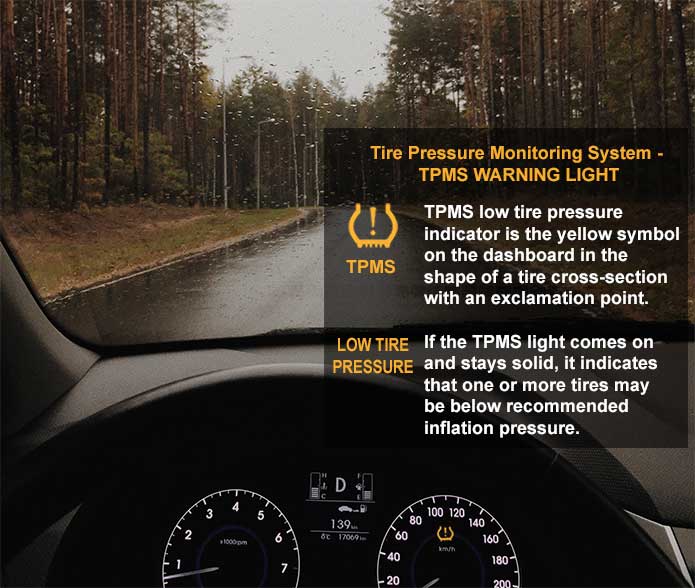Tire Pressure Monitoring System (TPMS) is an electronic, safety system in a vehicle that watches pressure in the vehicle's tires and alerts the driver when it's critically low. The alert can take the form of a warning indicator light on a vehicle's dashboard, an audible alarm, or both.

There are two types of the TPMS: direct and indirect (read more below), distinguished by the way how they get the data about tire pressure level i.e. low-pressure tire state.
No matter which type of the TPMS exists in your car, its main purpose is the same, maintaining the proper tire pressure that is essential for safety (i.e. preventing accidents), fuel economy, overall tire performance and extended tire life. The TPMS can help drivers stay aware of tire pressure issues before they become a bigger problem.
If the TPMS warning light appears on the dashboard, it's important to check your tire pressure at once. If one or more of your tires is underinflated, inflate it to the recommended tire pressure. Information about the recommended tire pressure is usually placed on driver's side door frame, inside car's fuel door, glove box or in the manual.
The TPMS is required by the law in most countries (now required on all new vehicles in the United States), and failure to keep properly inflated tires can result in fines or even accidents. It's important to regularly check tire pressure, even with the TPMS, as the system may not always be correct or may not detect slow leaks. Consider it just another item in your car maintenance toolbox.
Many newer cars come with the TPMS as a standard feature, but some older vehicles may require an aftermarket system to be installed.
Benefits of having Tire Pressure Monitoring System - TPMS
The TPMS can help you to maintain properly inflated tires, hence, it can help you to:
- Improve fuel economy because underinflated tires increase fuel consumption by up to 3%. The TPMS saves you money on gas;
- Extend tires' life because underinflated tires wear out more quickly. The TPMS saves you money on tires' replacements;
- Reduce the risk of accidents because underinflated tires can lead to tire blowouts, which can be dangerous and costly. The TPMS system improves your safety.

TPMS inner workings
How the TPMS system operates primarily depends on the way how it detects the low-pressure state in tires. Consequently, we can diferentiate two types of the TPMS: direct and indirect, but both systems serve the same purpose and activate the same indicator light.
- The Direct TPMS system typically includes a valve and sensor, mounted on a wheel inside each tire, to measure tire pressure. The TPMS sensor wirelessly sends real-time information regarding the pressure to an electronic control unit (ECU) that displays alert on the dashboard if the pressure in a tire is too low i.e. If the pressure in one or more of your tires is 25% or more below the vehicle manufacturer's recommended cold inflation tire pressure. The Direct TPMS systems can also detect and alert the driver about slow leaks, some sensors can give a warning if tire pressure or air temperature is too high, also.
- Provides actual tire pressure readings;
- Insusceptible to a tire diameter changes due to unevenly worn tires, tire rotations or tire replacements;
- Auto-resync after tire inflation, rotation or replacements;
- More expensive overall than its counterpart;
- If a sensor battery is drained, the sensor usually must be changed;
- Sensors are prone to damage during a tire mounting/demounting;
- Proprietary systems can make installation and service confusing.
- The Indirect TPMS system uses wheels' speed sensors of the anti-lock braking system (ABS) to approximate changes in tire pressure. When the tire is underinflated, it will rotate slightly faster than other tires. The ABS sensors detect this difference in rotation speed and send a signal to the ECU, which turns on the TPMS warning light.
- Less expensive than direct TPMS;
- Requires less installation and maintenance work than direct TPMS.
- May become inaccurate due to tire diameter differences (e.g. tires are unevenly worn);
- Needs reset after a tire inflating or rotation.
Benefits of direct tpms:
Drawbacks of direct tpms:
Benefits of indirect tpms:
Drawbacks of indirect tpms:
Tire pressure monitoring sensor - TPMS sensor
Some TPMS sensors, besides low pressure, can also watch high tire pressure and tire temperature, which can help detect potential tire failures due to overheating. In addition to alerting the driver of low or high tire pressure, the TPMS may also provide information on individual tire pressure readings, allowing drivers to identify which tire may need attention.
The TPMS sensor battery can last up to 10 years with normal use. When the battery fails, the sensor may need to be replaced.
How do you know that tire pressure is low or whether the TPMS works properly?
Note: This may vary between vehicles.
If the TPMS warning symbol comes on and stays solid with messages like the following: "Check Tire Pressure", "Low Tire Pressure" or "Add Air To Tire"; check and inflate all tires to the recommended tire pressure, then drive, to turn the alert off. If the TPMS symbol is blinking for more than one minute and stays solid, then the diagnostic service is needed. If your car TPMS is not working, it cannot detect and signal the low tire pressure condition.
Related articles:
- Types of tires - Find out which tire type to choose: summer, winter, all season, standard or high performance tire?
- When Should I Replace My Tyres? - How Many Tyres Should I Replace? Which Size Should I Buy? Summer, Winter, or All Season Tyre?
- Tire size designation - Tire size designations can be found on the tire sidewall, find out how to read them.
